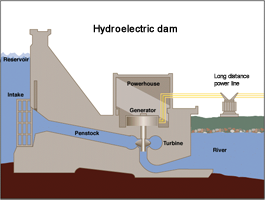Energy from moving water

Source: Adapted from National Energy Education Development Project (public domain)

Source: Tennessee Valley Authority (public domain)
Hydropower generates electricity
Hydropower is the largest renewable energy source for electricity generation in the United States. In 2015, hydropower accounted for about 6% of total U.S. electricity generation and 46% of electricity generation from all renewables.
Because the source of hydroelectric power is water, hydroelectric power plants are usually located on or near a water source.
Hydropower relies on the water cycle
Understanding the water cycle is important to understanding hydropower. The water cycle has three steps:
- Solar energy heats water on the surface of rivers, lakes, and oceans, which causes the water to evaporate.
- Water vapor condenses into clouds and falls as precipitation (rain, snow, etc.).
- Precipitation collects in streams and rivers, which empty into oceans and lakes, where it evaporates and begins the cycle again.
The amount of precipitation that drains into rivers and streams in a geographical area determines the amount of water available for producing hydropower. Seasonal variations in precipitation and long-term changes in precipitation patterns, such as droughts, have a big impact on hydropower production.
Hydroelectric power is produced from moving water
The volume of the water flow and the change in elevation (or fall) from one point to another determine the amount of available energy in moving water. Swiftly flowing water in a big river, like the Columbia River that forms the border between Oregon and Washington, carries a great deal of energy in its flow. Water descending rapidly from a high point, like Niagara Falls in New York, also has substantial energy in its flow.
At both Niagara Falls and the Columbia River, water flows through a pipe, or penstock, then pushes against and turns blades in a turbine to spin a generator to produce electricity. In a run-of-the-river system, the force of the current applies pressure on a turbine. In a storage system, water accumulates in reservoirs created by dams and is released as needed to generate electricity.
History of hydropower
Hydropower is one of the oldest sources of energy for producing mechanical and electrical energy. Hydropower was used thousands of years ago to turn paddle wheels to help grind grain. Before steam power and then electricity were available in the United States, grain and lumber mills were powered directly with hydropower. The first industrial use of hydropower to generate electricity in the United States occurred in 1880, when 16 brush-arc lamps were powered using a water turbine at the Wolverine Chair Factory in Grand Rapids, Michigan.
The first U.S. hydroelectric power plant opened on the Fox River near Appleton, Wisconsin, on September 30, 1882.




